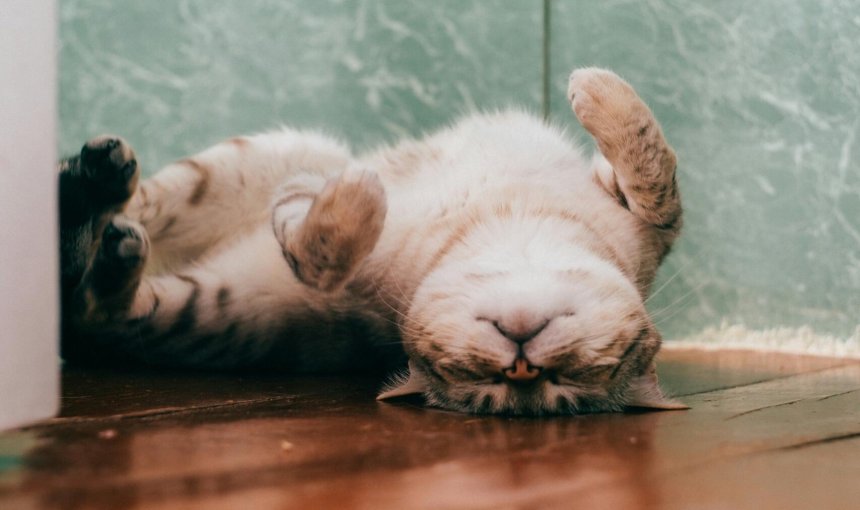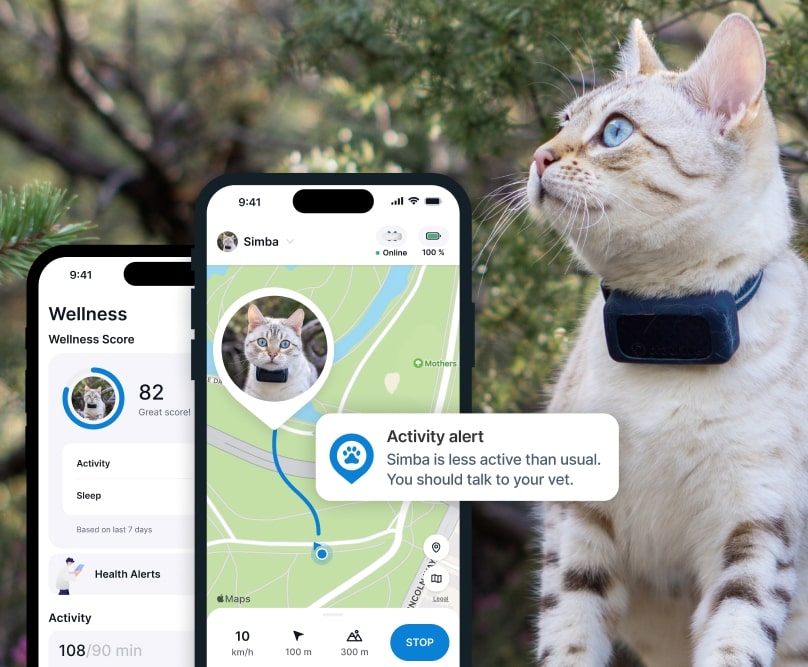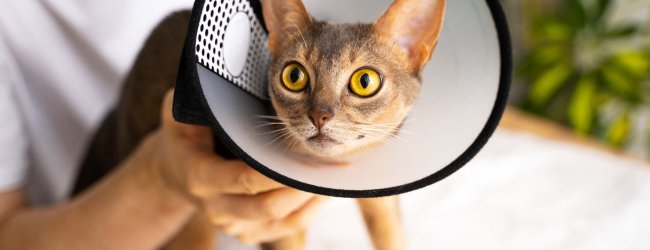Lethargy In Cats: Why It Happens & How To Handle It
From medications to more serious health conditions, don't skip these red flags if you're dealing with a lethargic cat at home.

Cats tend to be super sleepers, but there’s a big difference between one snoozing away and one that’s struggling with lethargy. If you’ve noticed that your feline buddy has been less active, slower, or just seems “off,” it can be worrying — especially if they’re normally playful. Let’s break down what you need to know about lethargy in cats, what red flags to watch out for, and how to help your feline buddy feel better. (Including how to spot a drop in your cat’s activity that much earlier.)

Find out where your cat spends their time.
Read more- What is lethargy in cats?
- Lethargic cat – or just tired? Signs to watch out for
- Why is my cat lethargic?
- Red flags that signal it’s time to head to the vet
- What to expect at your vet’s
- How you can care for your lethargic cat at home
- How a cat Activity Tracker helps you detect lethargy early
- Help your lethargic cat feel better in no time
- Stay on top of your cat’s wellness
What is lethargy in cats?
Lethargy is more than just sleepiness — it’s a noticeable drop in your cat’s energy levels, activity, and alertness. A lethargic cat may be less interested in their surroundings, their favorite toys, or even in you. They may avoid climbing their cat tree, groom themselves less, or be reluctant to move from their resting spot. If you notice these signs, it’s important you tune in closely to what else might be happening.
Lethargy is often linked to underlying health issues. It can be a symptom of many different illnesses, ranging from minor infections to serious systemic diseases. Common causes of lethargy can include infections, chronic illnesses, dehydration, or even emotional stress.

“Lethargy is a cat slowing down when they don’t feel well.
In many cases, lethargy is the body’s way of conserving energy to fight off illness or heal from injury.”
– PetMD1
Sadly, cats are masters at hiding pain and discomfort. So lethargy can be one of the first noticeable signs that your cat is unwell. Meaning, it makes sense to keep an eye out for the signs before your cat’s condition worsens.
💡 An Activity Tracker for cats can be an important early detection tool – helping you spot a drop in your cat’s active minutes that much quicker. (We’ll cover it in detail a little further below.)
Lethargic cat – or just tired? Signs to watch out for
A tired cat might regain their energy once they’ve slept a bit and eaten their meals. A lethargic cat might not – rather, their “tiredness” may persist longer than usual. Here are some tell-tale signs that can help you spot the difference between a lethargic cat and one that’s just tired:
- Lack of interest
Your cat doesn’t show the same enthusiasm for playing, exploring, or interacting. - Hiding
Cats that feel unwell may seek out quiet, hidden spaces where they can rest undisturbed. - Poor grooming
If your cat’s coat looks dull or unkempt, it might mean they lack the energy to groom themselves. - Changes in appetite or thirst
A cat that’s lethargic but still eating and drinking might have a milder issue, whereas refusing to eat or drink is a much more serious red flag. - Weakness
If a young cat suddenly seems weak or struggles to jump onto a favorite perch, this is a concerning symptom. - Sleeping more than usual
Cats sleep anywhere between 12-20 hours throughout the day. An increase can definitely signal something’s not right.
Generally, cats grow lethargic because their immune systems are working harder to fight off an infection or a “threat” to their bodies. This can make them appear tired and out of it.
⚠️ All cats are at risk for growing lethargic – especially if there’s something bothering them, health-wise. Kittens’ immune systems aren’t fully developed and senior cats tend to be more vulnerable to health risks as they grow older. So they might show these signs more quickly and more severely.
Why is my cat lethargic?
There are a whole bunch of potential causes of lethargy in cats, ranging from mild to severe. Your cat might be lethargic, for example, after getting vaccinated or taking some types of medication. (Though it shouldn’t last longer than 24-48 hours – kind of like in us humans.)
But if it persists, it may be due to:
- Infections
Viral, bacterial, parasitic, or fungal infections can cause your cat to feel unwell and drain their energy. Upper respiratory infections or abscesses are common culprits. - Chronic illnesses
Conditions such as kidney disease, cancer, heart disease, diabetes, inflammatory diseases, and hyperthyroidism can all cause a decrease in energy levels over time. - UTI
Besides lethargy, watch out for any change in your cat’s toilet habits. (Like if they’re visiting the litter box more often than usual – but don’t seem to be peeing as much.) - Dehydration
If your cat isn’t drinking enough water, they can quickly become dehydrated, which can make them lethargic. Dehydration can be especially dangerous for cats and often requires prompt treatment. - Pain or Injury
Cats that are in pain due to an injury or underlying condition, such as arthritis, may become less active as they try to avoid discomfort. - Emotional stress
Changes in the environment, such as moving to a new home, the introduction of a new pet, or the loss of a companion, can lead to stress and lethargy in cats. - Neurological disorders
Including cat dementia, which can make them confused and disoriented. - Poisoning
From exposure to toxic substances, including certain plants, household chemicals, or human foods - Anemia
A reduction in red blood cells can lead to lethargy, weakness, and pale gums. Anemia can be caused by various underlying issues, including parasites or chronic disease. - Nutritional deficiencies
Red flags that signal it’s time to head to the vet
Get in touch with your vet if you notice your cat is:
- Not eating or drinking and is very weak. This can lead to severe dehydration and can be life-threatening.
- Lethargic out of nowhere. Rapid changes like this can indicate something urgent – including poisoning.
- Vomiting, has diarrhea, or is breathing abnormally in addition to being lethargic.
- In pain, such as crying out, limping, or growling when touched.
- Wobbling around or seems unsteady on their feet, which could indicate a neurological problem.
- Drooling on top of being lethargic.
- Losing weight without any reason.
What to expect at your vet’s
When you bring your cat to the vet, they’ll start with a thorough physical examination and ask about any changes you’ve noticed. Be prepared to answer questions like when the lethargy started, whether your cat is eating and drinking, and if there have been any changes in litter box habits.
Your vet might also perform:
- Blood and/or urine tests to check for infections, organ function, or other internal issues.
- Imaging, like X-rays or ultrasounds, to look for anything unusual, like blockages or growths.
- An examination of your cat’s stool for any bacteria or parasites.
Depending on the diagnosis, treatment could involve anything from antibiotics for an infection to supportive care, like fluids to rehydrate your cat. If it’s a mobility-affecting condition like arthritis, your vet can recommend special supplements, cat beds, or indoor stairs to help your feline buddy find it less painful getting around.
How you can care for your lethargic cat at home
- Encourage your cat to drink
Make sure fresh water is always available. Consider a cat water fountain to entice them to drink more. Else, your vet can best advise you whether a hydration supplement can help. - Get them comfy
Offer a quiet, cozy place where your cat can rest comfortably without being disturbed. - Tempt your cat to eat
If your cat isn’t eating, try offering something they love, like a bit of wet food or a favorite treat. If they still won’t eat, it’s definitely time for a vet visit. - Help your cat destress
A pheromone diffuser can help your cat feel more relaxed indoors. Else, make sure they’ve got plenty of toys and treat dispensers (and ideally, some company) to keep them occupied when you’re not home. - Monitor a change in your cat’s activity
A cat Activity Tracker, like Tractive, can help you keep tabs on their energy levels and alert you early if there’s a sudden drop in activity. Early detection can make a big difference in catching underlying issues before they become serious.
How a cat Activity Tracker helps you detect lethargy early
With its built-in motion detector, your trusty Tractive device both helps you figure out where your cat’s off wandering – but also how often they were on the move. (Or on the snooze.) Logging in your cat’s daily activity as “active minutes” and its sleep as “sleep minutes.”
Now if there’s a weird drop in your cat’s activity that might signal an illness, infection, or lethargy…

💡 …you get a Health Alert straight to your inbox, helping you catch on earlier to the signs your cat might not be feeling their 100%.
So you can head to your vet right away for a checkup – before your cat’s health takes a turn for the worse.
Help your lethargic cat feel better in no time
Here’s a wrap-up of the key takeaways of the post, so you can better care for your lethargic cat and get them the care they need early on.
- Lethargy in cats is a noticeable drop in energy that can indicate a health issue.
- Watch for symptoms like weakness, hiding, lack of grooming, and changes in eating or drinking habits.
- Head to the vet if your cat is refusing food and water, has sudden lethargy, or shows other concerning symptoms like vomiting, pain, difficulties moving, or drooling.
- Home care can help, including hydration, comfort, and monitoring their activity with tools like an Activity Tracker.
If your cat is feeling lethargic, don’t wait too long to act. Cats can be very good at hiding discomfort, so it’s important you catch on to the signs early. With a little extra care and the right attention, you can help your cat get back to their playful, loving self in no time.

“Great little tracker, perfect size and weight for cats.
Tracks activity and sleep habits making it easier to spot issues and discuss activity levels with her vet. Also tracks her when she decides to roam the neighborhood.”
– Clayton Ward, (Source: Trustpilot)

Stay on top of your cat’s wellness
See where they are in real-time, no matter how far they go. Get alerts if they roam too far from home. Find out where they’ve been and discover their favorite spots. Let others track with you. Track sleep and activity.
For more expert tips, here’s Dr. Bobby Cawthron from Aspen Grove Veterinary Care sharing all the reasons why dogs and cats get lethargic.
And if you’ve liked this post, share it with a friend or a loved one – and let’s help build a safer, kinder world for our furry friends together.




